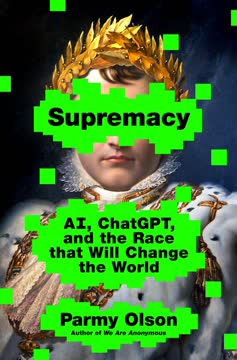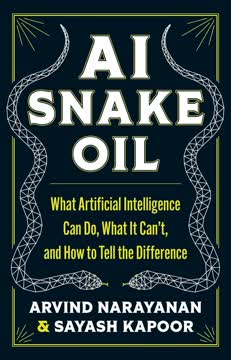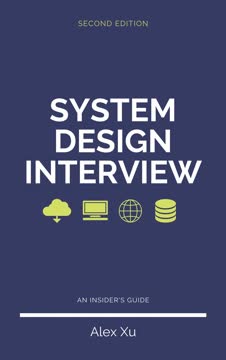Key Takeaways
1. Large Language Models are powerful text processors built on deep learning.
LLMs have remarkable capabilities to understand, generate, and interpret human language.
Deep learning foundation. Large Language Models (LLMs) are advanced deep neural networks trained on massive text datasets, enabling them to process and generate human-like text. They represent a significant leap from traditional natural language processing methods, excelling at complex tasks like contextual analysis and coherent text creation. LLMs are a specific application of deep learning, which is a subset of machine learning focused on multi-layer neural networks.
Generative AI. LLMs are often categorized as generative AI because they can create new content, specifically text. Their ability to understand and generate language makes them versatile tools for tasks ranging from simple grammar checks to writing articles, code, and powering sophisticated chatbots. This generative capability stems from their training objective, typically predicting the next word in a sequence.
Transformer architecture. The success of modern LLMs is largely attributed to the transformer architecture and the immense scale of their training data. This architecture, particularly the decoder-only variants like GPT, is designed for sequential text generation. While LLMs are large in terms of parameters and data, understanding their core components reveals they are not entirely "black boxes."
2. Text data must be tokenized and embedded into numerical vectors for LLMs.
Deep neural network models, including LLMs, cannot process raw text directly.
Numerical representation is key. LLMs, being neural networks, require input data in a numerical format. Raw text, being categorical, must be converted into continuous-valued vectors, a process known as embedding. This transformation allows the mathematical operations within the neural network to process language.
Tokenization breaks down text. The first step in preparing text is tokenization, splitting text into smaller units called tokens, which can be words, subwords, or special characters. These tokens are then mapped to unique integer IDs based on a predefined vocabulary. Advanced methods like Byte Pair Encoding (BPE) handle unknown words by breaking them into known subword units or characters, ensuring the model can process any text.
Embeddings create vectors. Token IDs are then converted into embedding vectors, typically using an embedding layer within the LLM itself. This layer acts as a lookup table, mapping each token ID to a dense vector representation. These vectors capture semantic relationships, allowing words with similar meanings to have similar vector representations, and are optimized during the LLM's training.
3. Attention mechanisms enable LLMs to weigh the importance of different input parts.
Self-attention is a mechanism that allows each position in the input sequence to consider the relevancy of, or “attend to,” all other positions in the same sequence when computing the representation of a sequence.
Addressing sequence limitations. Earlier models like Recurrent Neural Networks (RNNs) struggled with long sequences because they had to compress all input information into a single hidden state. Attention mechanisms were developed to allow the model to selectively focus on different parts of the input sequence when processing a specific element or generating an output.
Self-attention within the sequence. Self-attention, a core component of transformers and LLMs, allows each token in an input sequence to interact with and weigh the importance of all other tokens within the same sequence. This enables the model to capture long-range dependencies and contextual relationships, crucial for understanding language nuances.
Queries, Keys, and Values. Self-attention works by projecting input embeddings into three learned vectors: queries, keys, and values. Attention scores are computed by comparing queries to keys (often via dot products), indicating how much attention a token should pay to others. These scores are normalized into attention weights, which are then used to compute a weighted sum of the value vectors, resulting in context vectors that are enriched representations of each input token.
4. The GPT architecture stacks transformer blocks for text generation.
GPT models... are large deep neural network architectures designed to generate new text one word (or token) at a time.
Decoder-only design. Unlike the original transformer with both encoder and decoder, GPT models utilize only the decoder part. This architecture is specifically designed for unidirectional, left-to-right processing, making it highly effective for text generation tasks where the model predicts the next token based on the preceding sequence.
Transformer blocks are the core. The GPT architecture is built by stacking multiple identical transformer blocks. Each block processes the input sequence, refining the token representations through self-attention and feed-forward networks. The number of these blocks is a key factor in the model's size and capacity, ranging from 12 in the smallest GPT-2 to 48 in the largest.
Sequential generation. Text generation in GPT is an iterative process. Given an initial prompt, the model processes the sequence through its layers, and the output layer predicts the probability distribution over the vocabulary for the next token. The most likely token (or one sampled probabilistically) is selected, appended to the input sequence, and the process repeats, building the output text one token at a time.
5. Layer normalization and shortcut connections stabilize deep LLM training.
Training deep neural networks with many layers can sometimes prove challenging due to problems like vanishing or exploding gradients.
Stabilizing activations. Layer normalization is a technique applied within transformer blocks to stabilize the training process of deep networks. It normalizes the outputs (activations) of a layer to have a mean of 0 and a variance of 1 across the feature dimension for each individual input example. This helps prevent internal covariate shift and allows for more stable and faster convergence during training.
Mitigating gradient issues. Shortcut connections, also known as skip or residual connections, are crucial for training very deep neural networks like LLMs. They involve adding the input of a layer or block directly to its output, creating an alternative path for gradients to flow during backpropagation. This helps combat the vanishing gradient problem, ensuring that gradients remain sufficiently large to update the weights in earlier layers effectively.
Building robust blocks. Within a transformer block, layer normalization is typically applied before the multi-head attention and feed-forward network, and shortcut connections are added after these components. This combination ensures that the deep network can learn complex patterns while maintaining stable gradient flow and preventing training from stagnating, making the architecture scalable to many layers.
6. Pretraining on vast unlabeled text creates a versatile foundation model.
The next-word prediction task is a form of self-supervised learning, which is a form of self-labeling.
Initial training phase. Pretraining is the first and most computationally intensive stage in building an LLM. It involves training the model on a massive corpus of unlabeled text data, often billions or trillions of words from diverse sources like websites, books, and articles. This large-scale exposure allows the model to learn grammar, syntax, facts, and general language patterns.
Self-supervised learning. The primary pretraining task for GPT-like models is next-word prediction: given a sequence of tokens, the model learns to predict the next token. This is a self-supervised task because the labels (the next tokens) are derived directly from the input data itself, eliminating the need for manual labeling and enabling the use of vast amounts of raw text.
Foundation model capabilities. The result of pretraining is a foundation model (or base model) capable of text completion and exhibiting emergent properties like limited few-shot learning. While not yet specialized for specific tasks, this pretrained model serves as a powerful base that has learned a broad understanding of language, ready to be adapted for various downstream applications through fine-tuning.
7. Loading pretrained weights bypasses expensive initial training.
Fortunately, OpenAI openly shared the weights of their GPT-2 models, thus eliminating the need to invest tens to hundreds of thousands of dollars in retraining the model on a large corpus ourselves.
Cost and resource savings. Pretraining large LLMs from scratch is prohibitively expensive, requiring significant computational resources and time. Loading publicly available pretrained weights, such as those from OpenAI's GPT-2 models, allows developers to leverage the extensive pretraining already performed, saving substantial costs and resources.
Starting point for adaptation. Pretrained models serve as excellent starting points for various tasks. Their learned language understanding can be transferred to new domains or specific applications with much less data and computation than training from zero. This makes LLMs accessible for fine-tuning even on consumer hardware.
Compatibility and architecture. To load pretrained weights, the architecture of the local model implementation must match that of the pretrained model, including layer types, dimensions, and initialization details like bias usage. While minor architectural differences might exist (like weight tying in the original GPT-2 output layer), careful mapping of weights ensures the loaded model functions correctly and retains the capabilities learned during pretraining.
8. Fine-tuning adapts LLMs for specific classification tasks.
In classification fine-tuning... the model is trained to recognize a specific set of class labels...
Specialized task adaptation. Fine-tuning is the second stage of the LLM development cycle, where a pretrained foundation model is adapted for specific downstream tasks using smaller, labeled datasets. Classification fine-tuning involves training the model to categorize input text into predefined classes, such as "spam" or "not spam," sentiment labels, or topic categories.
Modifying the output layer. For classification, the model's original output layer, designed to predict the next token across a large vocabulary, is replaced with a smaller linear layer. This new layer maps the model's final hidden representation to the specific number of classes required for the task (e.g., 2 for binary classification).
Training on labeled data. The model is then trained on a labeled dataset where each text example is paired with its correct class label. Only the newly added classification layer and potentially the last few layers of the pretrained model are made trainable, while the majority of the pretrained weights are frozen. This process adjusts the model to output the correct class probabilities for the given inputs, evaluated using metrics like cross-entropy loss and classification accuracy.
9. Instruction fine-tuning teaches LLMs to follow human commands.
Instruction fine-tuning involves training a language model on a set of tasks using specific instructions to improve its ability to understand and execute tasks described in natural language prompts...
Enabling conversational AI. Instruction fine-tuning is a crucial step in developing LLMs for interactive applications like chatbots and personal assistants. It trains the model to understand and respond appropriately to instructions phrased in natural language, moving beyond simple text completion to task execution based on user prompts.
Instruction-response pairs. This process uses a dataset consisting of instruction-response pairs, often formatted using specific prompt templates (like the Alpaca style) to structure the input for the model. The model is trained to generate the desired response text given the instruction and any associated input context.
Training process. Similar to pretraining, instruction fine-tuning uses a next-token prediction objective, but the targets are the tokens of the desired response following the instruction. Custom data loaders handle variable-length inputs by padding sequences and masking padding tokens in the loss calculation. The pretrained model's weights are adjusted to minimize the difference between the model's generated response tokens and the target response tokens, enabling it to learn the mapping from instructions to desired outputs.
Last updated:
Review Summary
"Build a Large Language Model" is highly praised for its comprehensive, step-by-step approach to understanding and implementing LLMs. Readers appreciate its clear explanations, practical code examples, and balanced mix of theory and application. The book covers everything from transformer basics to fine-tuning models for specific tasks. Many find it an invaluable resource for both beginners and experienced practitioners in the field of AI and machine learning. Some reviewers note that while the book excels in explaining "how," it could delve deeper into the "why" behind certain concepts.
Similar Books










Download PDF
Download EPUB
.epub digital book format is ideal for reading ebooks on phones, tablets, and e-readers.




